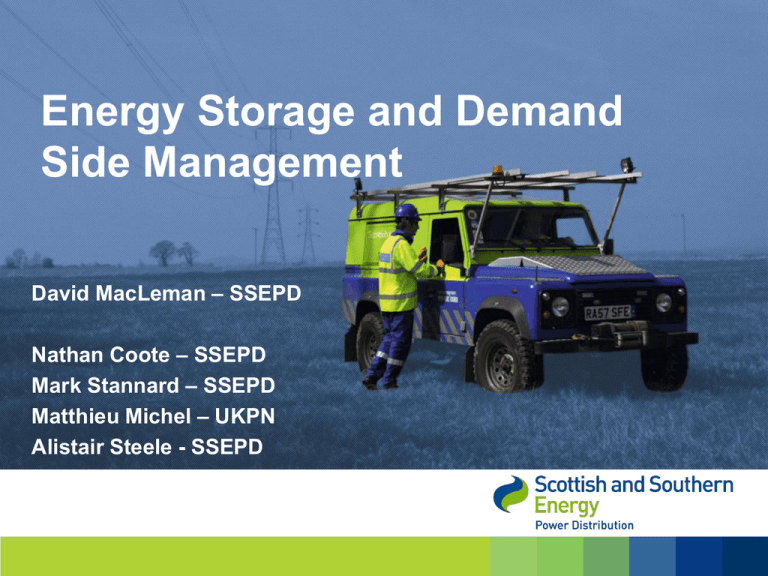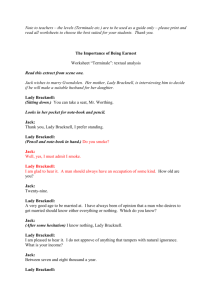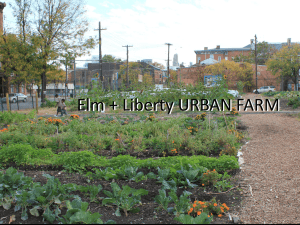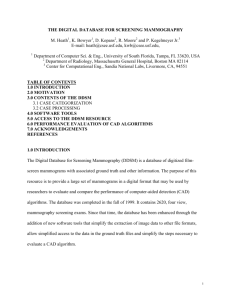PowerPoint File
advertisement

Energy Storage and Demand Side Management David MacLeman – SSEPD Nathan Coote – SSEPD Mark Stannard – SSEPD Matthieu Michel – UKPN Alistair Steele - SSEPD What are we really trying to do with Energy Storage? Balance generation and demand locally and nationally Manage energy flow within a network constraints Keep the lights on Energy storage continuum Domestic Commercial Industrial New entries (cars)....... Small scale thermal Mass Manufacture process management District Heating...... Batteries Flow Batteries Thermal conversion Pump storage Flywheels...... Sabatier process (Methane) Electrolysis (Hydrogen) Haber Process (Ammonia) Inter sector energy exchange... Trial evaluation of domestic demand side management Nathan Coote Scope Project overview Success criteria Functionality Outcomes and learning Conclusions and future work Project Overview Dimplex prototype devices installed during the SSET1003 trial Success Criteria The project success criteria will be to prove the integration of the technologies and provide knowledge and lessons learned for the NINES project and other DNO projects. Functionality Frequency response of Smart Loads 120% 80% Smart load 50% gradient with 50% load at 50Hz 60% Smart load 25% gradient with 43% load at 50Hz Smart load 200% gradient with 43% load at 50Hz 40% 20% 0% 49 49.1 49.2 49.3 49.4 49.5 49.6 49.7 49.8 49.9 50 50.1 50.2 50.3 50.4 50.5 50.6 50.7 50.8 50.9 51 Rated Power [%] 100% Frequency [Hz] Trial Participant Recruitment Six homes identified Personal visit to explain project £100 ex-gratia payment Testing Technology Readiness Level (TRL) 9 8 7 6 } Proven Technology } Demonstration } Applied R&D } Research 5 4 3 Prototype System Validation Demonstration (relevant environment) (operational environment) 2 1 ESRU Outcomes and key learning Development of a DDSM heating system Hot Water Cylinder Main Design Features: Class leading insulation Three core elements providing variable power input Increased storage capacity Energy Storage Capacity: Maximum Storage Capacity (10-80 oC) 175 l 14.0 kWh 215 l 17.1 kWh Outcomes and key learning Development of a DDSM heating system Storage Heaters Main Design Features: Highly insulated storage core Three core elements providing variable power input Electronic controller Energy Storage Capacity: Maximum Storage Capacity P100 12.1 kWh P125 14.9 kWh Outcomes and key learning Development of a DDSM heating system New switching strategy Requirements for a communications solution Hot water cylinder temperature measurement Wireless solution Outcomes and key learning Other learning outcomes Resource requirements Understanding of customer perceptions Skills development and safe working procedures Input to further academic work on modelling household energy use to forecast customer demand Conclusions and future work The trial has demonstrated the functionality of a DDSM system and provided an initial indication of the network and customer benefits. The next step required for progression towards Business As Usual (BAU) deployment is to trial dynamic scheduling and control. A large-scale roll out to 750 homes in Shetland through SHEPD’s NINES project will enable this. Allow SHEPD to determine the value of DDSM to DNO’s. Honeywell Automated Demand Response Mark Stannard Overview • Pilot demonstration of Honeywell's Automated Demand Response (ADR) solution – Enable DNO to reduce non-domestic demand at strategic points on the network – Load shed triggered via signal to existing building management systems • Benefits – Match electrical distribution needs to changing customer demand profiles – Provide visibility of customer usage – Re-engage with customers to enhance future planning Trialling method • Deployed at 3 customer sites: – Bracknell & Wokingham College – Bracknell Forest Council – Honeywell House • Sites: >200kW use, DR programming change to BMS, individual load shed event participation or opt out • Test capability of ADR to: – Produce an aggregated figure of despatchable demand – Reduce/shift peak loads Trial load shed event – single site Aggregated load shed event Site Average kW shed Honeywell House 70 kW Bracknell & Wokingham College 56 kW Bracknell Forest Council 11 kW Aggregated load shed event Honeywell House 75 kW Aggregated load shed event Bracknell & Wokingham College 81 kW Aggregated load shed event Bracknell Forest Council 11 kW Customer Engagement Framework Using the information regarding the steps and time taken to acquire customers we have calculated the cost it took to get to sign up stage Although a limited sample, it provides a valid indicative cost to a DNO associated with recruitment for this type and scale of trial. Customer Engagement Framework kW Shed Cost to DNO Cost per MW load shed (£k) Bracknell & Wokingham College 56 798 14.250 Bracknell Forest Council 11 436 39.636 Honeywell 70 206 2.943 Overall 137 1440 10.511 Building (company) Value to a DNO • Modelling was performed to extrapolate results in more detail. • Began to understand how ADR can improve network observability on the distribution network Conclusions/ Next Steps • Capable of shedding load in commercial properties by communicating with the existing BMS • Load shed can be triggered simultaneously to perform an aggregated load shed • maximum aggregated load shed of 137kW • Streamlined Customer Engagement is Key









